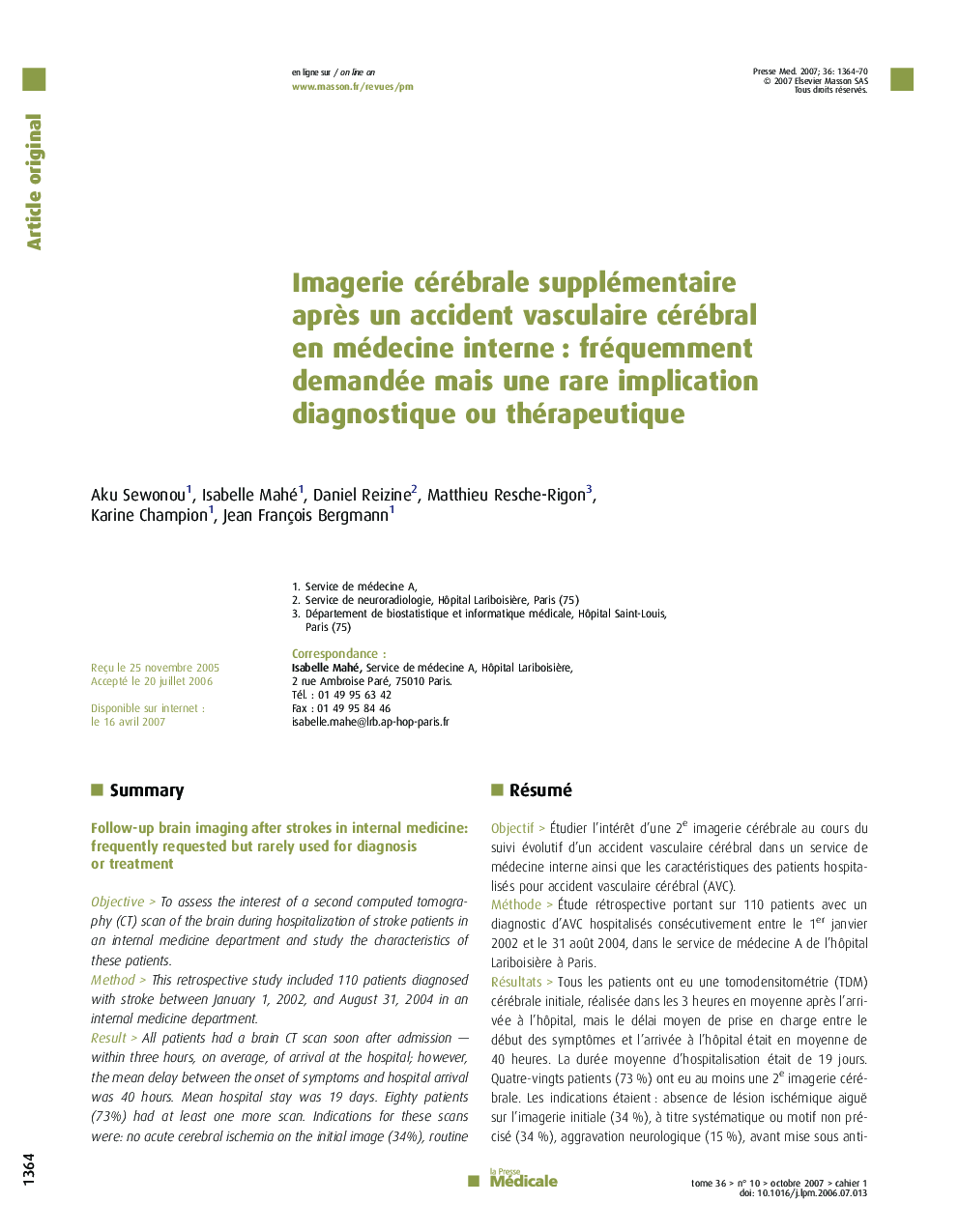| Article ID | Journal | Published Year | Pages | File Type |
|---|---|---|---|---|
| 3819236 | La Presse Médicale | 2007 | 7 Pages |
SummaryObjectiveTo assess the interest of a second computed tomography (CT) scan of the brain during hospitalization of stroke patients in an internal medicine department and study the characteristics of these patients.MethodThis retrospective study included 110 patients diagnosed with stroke between January 1, 2002, and August 31, 2004 in an internal medicine department.ResultAll patients had a brain CT scan soon after admission — within three hours, on average, of arrival at the hospital; however, the mean delay between the onset of symptoms and hospital arrival was 40 hours. Mean hospital stay was 19 days. Eighty patients (73%) had at least one more scan. Indications for these scans were: no acute cerebral ischemia on the initial image (34%), routine follow-up or reason not specified (34%), worsening of neurologic status (15%), before oral anticoagulation (5%), to search a tumor (5%), to look for a cause (4%), and clinic-radiologic discordance (3%). Only 29% of the indications had any diagnostic or therapeutic reason. Among these 80 patients, the repeat brain scan resulted in a change in the initial diagnosis for 4 patients (5%) and in a change of therapy for 11 (14%).ConclusionIn our study, repeat CT imaging was frequently ordered in ischemic stroke, despite the not uncommon absence of any diagnostic or therapeutic reasons. To optimize the use of medical resources and avoid unnecessary imaging, it would be useful to identify subgroups of patients for whom repeat imaging might be of interest.
RésuméObjectifÉtudier l'intérêt d'une 2e imagerie cérébrale au cours du suivi évolutif d'un accident vasculaire cérébral dans un service de médecine interne ainsi que les caractéristiques des patients hospitalisés pour accident vasculaire cérébral (AVC).MéthodeÉtude rétrospective portant sur 110 patients avec un diagnostic d'AVC hospitalisés consécutivement entre le 1er janvier 2002 et le 31 août 2004, dans le service de médecine A de l'hôpital Lariboisière à Paris.RésultatsTous les patients ont eu une tomodensitométrie (TDM) cérébrale initiale, réalisée dans les 3 heures en moyenne après l'arrivée à l'hôpital, mais le délai moyen de prise en charge entre le début des symptômes et l'arrivée à l'hôpital était en moyenne de 40 heures. La durée moyenne d'hospitalisation était de 19 jours. Quatre-vingts patients (73 %) ont eu au moins une 2e imagerie cérébrale. Les indications étaient : absence de lésion ischémique aiguë sur l'imagerie initiale (34 %), à titre systématique ou motif non précisé (34 %), aggravation neurologique (15 %), avant mise sous antivitamine K (5 %), recherche d'une tumeur sous-jacente (5 %), bilan étiologique (4 %), discordance clinico-radiologique (3 %). Seulement 29 % des indications ont eu une implication diagnostique ou thérapeutique. Parmi ces 80 patients, 4 (5 %) ont eu une modification du diagnostic initial et 11 (14 %) une modification thérapeutique au terme de la seconde voire troisième imagerie cérébrale.ConclusionAprès la TDM cérébrale initiale, une imagerie cérébrale supplémentaire a été fréquemment demandée au cours du suivi d'un AVC dans notre étude. Souvent sans implication diagnostique ou thérapeutique pour le patient. Il serait intéressant d'identifier les sous-groupes de patients chez qui cette imagerie est bénéfique afin d'optimiser les ressources médicales et d'éviter les imageries inutiles.
